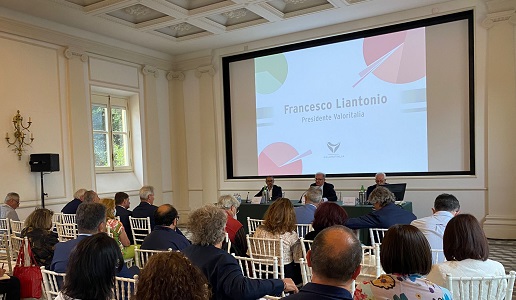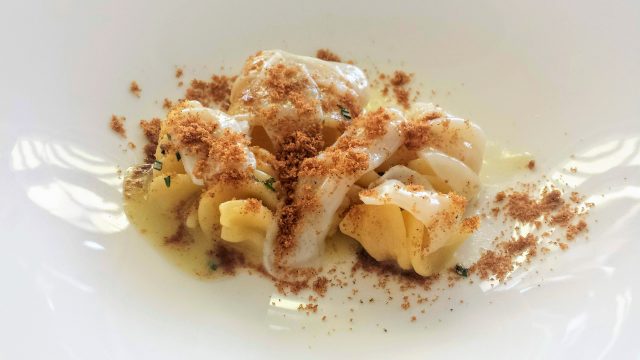Double-digit growth for Italy’s wine industry

Valoritalia Annual Report for 2022 presented in Rome. Brand awareness, organic brand and sustainability certification essential elements in purchasing choices.
The 2022 editions of Valoritalia's Annual Report, with data emerging from the certification processes of 218 Italian denominations of origin, and the Nomisma Wine Monitor - Valoritalia Observatory, an accurate analysis of the perception of certifications among wine companies and wine consumers, were presented in Rome, in the beautiful spaces of Villa Aurelia. In particular, this year's research followed two paths: monitoring this perception in the third year of the pandemic and comparing Italian and German consumers, both in their approach to PDO and PGI certified wines and towards BIO and Sustainable ones.
From Valoritalia's Annual Report emerges a snapshot of Vineyard Italy that confirms the sensations of recent months, especially the one concerning the increase in marketed volumes. Despite the difficult years, with sometimes catastrophic forecasts, sales are growing in double figures (+ 12%) and not only thanks to the surge in online sales.
"A balance in many ways surprising," stressed Francesco Liantonio, President of Valoritalia, "if we take into account what has happened in the last three years. Our Denominations of Origin have achieved an extraordinary performance, recording record growth, the result of the ability shown by our companies to seize every opportunity, cover every space, manage their potential to the fullest, and optimize resources and relationships."
Results that instill optimism, not only among industry players. Acting as the locomotive remains the northeast, with Pinot Grigio delle Venezie and the so-called "Prosecco System" (which includes the Prosecco DOC and the Conegliano-Valdobbiadene and Asolo DOCGs), with an overall growth that in the two-year period 2020-2021 touched 22.7 percent, for a total of just under 1 billion bottles. But also of note are the surges in other prestigious appellations, such as Brunello di Montalcino (+40%), Barolo (+27%), Gavi (+23%), Franciacorta (+12%), Chianti Classico (+11%), and Nobile di Montepulciano (+10%).
"There is truly a great deal of interesting data emerging from our Annual Report," commented Valoritalia General Manager Giuseppe Liberatore, "a mass of information produced by a staff of 231 collaborators and 1250 qualified consultants, distributed practically throughout the country. A close-knit team that daily sifts through 47 DOCGs, 134 DOCs, 37 IGTs and manages about 5,000 types of wine. Today we certify nearly 20 million hectoliters, equivalent to 56 percent of the national production of all DOs, for a total of nearly 2.1 billion bottles. In our system the movements of 95 thousand operators are managed, representing a large part of the entire wine sector. An extremely sophisticated organizational machine, unique in its kind, which constitutes a sort of worldwide benchmark."
A capillary work for the realization of a volume that in this edition is enriched with a new content. For the first time, in fact, the chemical-analytical profiles of 56 DOC and DOCG wines are made available. An in-depth study that has generated 60 tables whose base consists of about 176 thousand analyses, carried out between January 2017 and March 2022 by a network of accredited laboratories. A very valuable tool that can provide information on the main indicators that characterize the different vintages of each appellation, such as average alcohol content, acidity and dry extract. However, the future goal of Valoritalia is to progressively make usable to entrepreneurs, researchers and specialists, primarily oenologists, a complete and systematic data base of the analytical profile of all certified appellations, including the different types. A tool that will help define the specificities of each wine and accurately attribute vintage characters.
Finally, this year's Nomisma survey reserved an interesting space for the comparison between Italian and German consumers. This is not a random choice, taking into account that the Teutonic one remains, after the U.S., the main reference market for our wines, with an export value reaching 1.1 billion euros in 2021. In Germany, our labels beat those of France in the frequency of consumption (64 percent of Germans have drunk at least one Italian wine in the past 12 months), while we rank behind our transalpine cousins in the quality perception challenge.
The survey also shows that in both countries what directs consumers' choices are elements such as brand awareness, organic labeling and sustainability certification, with a marked sensitivity to production methods that respect environmental resources, origin and traceability of the supply chain. Finally, there is no shortage, in Germany as in Italy, of more sensitive consumers, who point the spotlight on the company's social and economic responsibility. A message that the Italian manufacturing world seems to have grasped and that has been determining the strategies of companies for some time, both in terms of production and communication and marketing. And the future, at least according to 75% of the 141 companies surveyed by Nomisma, belongs to sustainable and organic wines. A percentage still in the minority, but still growing compared to previous years, then points to low-alcohol, vegan or even alcohol-free wines.
"The survey, conducted on a sample of 1,000 Italian and an equal number of German consumers, highlights several similarities but also decidedly different approaches," explained Denis Pantini, Head of Agribusiness Wine Monitor at Nomisma. "For example, in home consumption both look mainly at territorial origin and brand awareness. But when leaving home and consuming in a restaurant or winebar, things change. For Italians, there are few differences from indoor consumption, while the German consumer prefers to be guided by the owner or wait staff. Italians focus a lot on geographical indication, Germans more on grape variety."

 Italiano
Italiano







